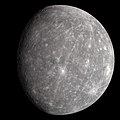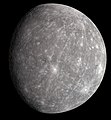Bestand:Mercury in true color.jpg
Uiterlijk

Grootte van deze voorvertoning: 600 × 600 pixels. Andere resoluties: 240 × 240 pixels | 480 × 480 pixels | 768 × 768 pixels | 1.040 × 1.040 pixels.
Oorspronkelijk bestand (1.040 × 1.040 pixels, bestandsgrootte: 408 kB, MIME-type: image/jpeg)
Bestandsgeschiedenis
Klik op een datum/tijd om het bestand te zien zoals het destijds was.
| Datum/tijd | Miniatuur | Afmetingen | Gebruiker | Opmerking | |
|---|---|---|---|---|---|
| huidige versie | 15 mei 2023 10:16 |  | 1.040 × 1.040 (408 kB) | CactiStaccingCrane | Reverted to version as of 10:42, 24 July 2022 (UTC) |
| 15 mei 2023 10:01 |  | 1.024 × 1.024 (837 kB) | CactiStaccingCrane | Manually merge the original monochrome image with the calibrated color image to eek out more resolution | |
| 24 jul 2022 12:42 |  | 1.040 × 1.040 (408 kB) | JCP-JohnCarlo | Make this planet image center | |
| 24 jul 2022 12:25 |  | 1.040 × 1.040 (710 kB) | JCP-JohnCarlo | Canvas image | |
| 3 nov 2019 11:00 |  | 960 × 1.040 (865 kB) | Mirecki | User created page with UploadWizard |
Bestandsgebruik
Geen enkele pagina gebruikt dit bestand.
Globaal bestandsgebruik
De volgende andere wiki's gebruiken dit bestand:
- Gebruikt op af.wikipedia.org
- Gebruikt op als.wikipedia.org
- Gebruikt op ar.wikibooks.org
- Gebruikt op as.wikipedia.org
- Gebruikt op be-tarask.wikipedia.org
- Gebruikt op beta.wikiversity.org
- Gebruikt op bn.wikibooks.org
- Gebruikt op bo.wikipedia.org
- Gebruikt op br.wikipedia.org
- Gebruikt op ceb.wikipedia.org
- Gebruikt op ckb.wiktionary.org
- Gebruikt op csb.wikipedia.org
- Gebruikt op cv.wikipedia.org
- Gebruikt op cy.wikipedia.org
- Gebruikt op de.wikipedia.org
- Gebruikt op dty.wikipedia.org
- Gebruikt op dz.wikipedia.org
- Gebruikt op eml.wikipedia.org
- Gebruikt op en.wikipedia.org
- Mercury (planet)
- Terrestrial planet
- The Planets
- Timeline of discovery of Solar System planets and their moons
- List of Solar System objects by size
- List of gravitationally rounded objects of the Solar System
- User:Kwamikagami/sandbox
- NASA
- User:Kazkaskazkasako/Books/Physical sciences
- Talk:Mercury (planet)/Archive 3
- User:Nrco0e/Userboxes
- User:Applekle/sandbox
- Wikipedia:Userboxes/Location/Extraterrestrial
- Talk:The Planets/GA1
- User:Double sharp/Largest Solar System objects
- User:TomMasterReal
- User:Nrco0e/Userboxes/FavMercury
- User:KeroseneLover100/sandbox/sandbox
- Gebruikt op en.wikibooks.org
- Gebruikt op en.wiktionary.org
- Gebruikt op eo.wikipedia.org
Globaal gebruik van dit bestand bekijken.


